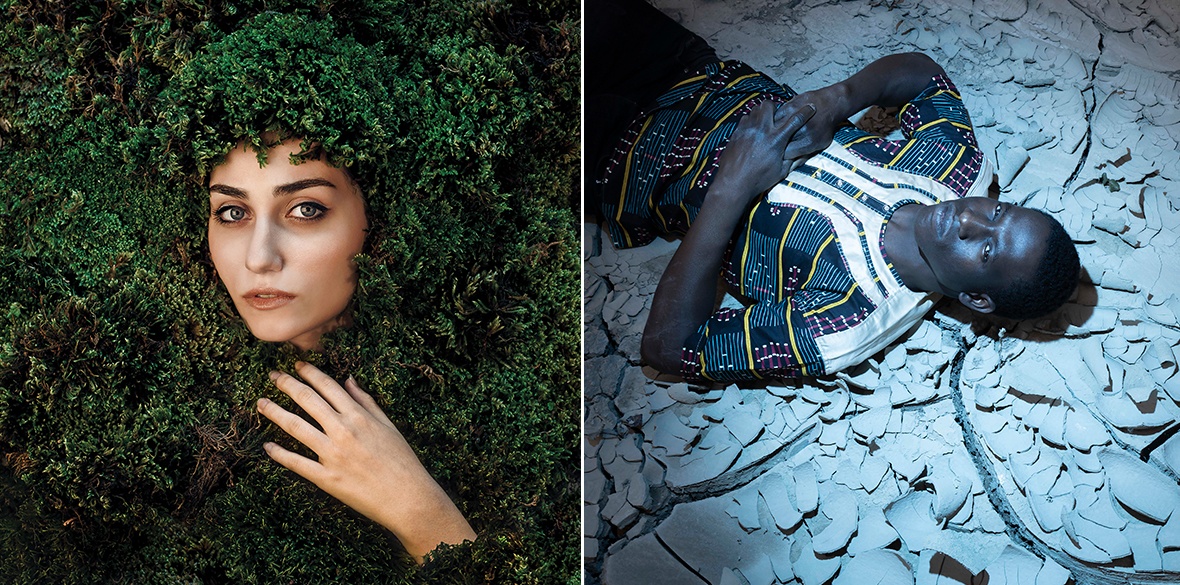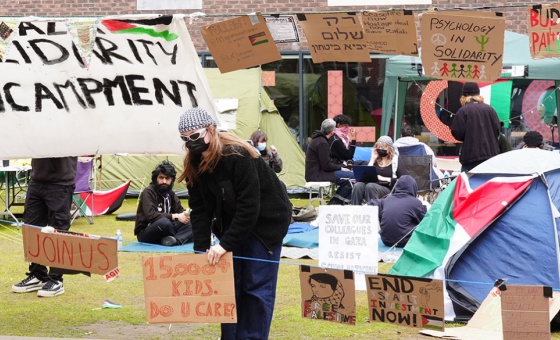This is the last article you can read this month
You can read more article this month
You can read more articles this month
Sorry your limit is up for this month
Reset on:
Please help support the Morning Star by subscribing here
THEY come from different countries — Iran, Afghanistan and Russia — and each has their own unique way of expressing themselves, but what they have in common is their militancy and commitment to female emancipation and social justice.
Their powerful images are at present on show at the Festival of LaGacilly/Baden — Europe’s biggest open-air photography festival.
Thirty-seven-year-old Iranian Maryam Firuzi did not set out to become a photographer. She has a degree in calligraphy and film studies, has studied art, literature and architecture. Today, she sees herself as an artist rather than “just” a photographer.
Her work is influenced by various art forms. “Calligraphy taught me discipline,” she says, “painting taught me freedom of expression and literature taught me how to develop ideas and articulate them.”
Her innovative vision is articulated in the photographic series she creates, in which she explores the work of women in present-day Iran. In one powerful series, she reflects on the notion of heritage, the wearing of the hijab and the significance of hair.
She grew up with shame, she says, “where you were forced to suppress the ability to express who you are. In my country, where gender is always a deeply sensitive issue in every aspect of society, is it even possible to circumvent my status as a woman in my work?
“Gender is so omnipresent that I often feel forced to think like a woman and create bodies of work that are only related to women.”
Her symbolic and metaphorical images challenge our notions of “classical” photography with bold, conceptual themes. She allows her imagination and dreams to take her where she wants to go.
“Coverage of the Middle East in Western media invariably focuses on the darker side,” she says. “When the subject is women, Western audiences immediately think of women behind veils. They are supposed to bear and nurture children, but to remain immured in their homes.
“A woman from the Middle East who is educated, successful and independent is portrayed as a rarity, although in Iran there are more highly educated women than men.”
In her photos, she reveals unusual, disturbing factettes of modern Iran, a country that can look back on centuries of magnificent culture, but which today has an Islamic dictatorship. And yet, artists like Firuzi can still find innovative ways to express what is banned and persecuted.
“But art allows one to test the boundaries of expression and also to test oneself — how much stamina and strength one has.”
In talking about her work, she has to choose her words carefully in order to avoid accusations of defaming the country or the authorities.

Afghan photographer and activist, Fatimah Hossaini (born 1993), managed to flee the Taliban’s return to Kabul in August 2021 and to rescue her beloved photos in her backpack.
Her project, documenting women’s struggles in Afghanistan, was brutally interrupted by the return of the Taliban. Today she lives in exile in France.
In her photos, she pays homage to the unique beauty, dignity and courage of Afghan women. Her compatriots have few opportunities to express themselves freely and face enormous hurdles at every juncture of their lives, so she hopes to give them a voice through her work.
Unable to express themselves as equals, Afghan women use textiles and colours to express themselves. Hossaini looks for hope and beauty beneath the oppression, a reflection of herself, finding colour and light in the darkness, the joylessness and the hopelessness.
Because women have few means of expressing themselves freely, their faces and their eyes take on a unique significance in her photos, challenging, protesting and demanding.
She had dreamed of becoming a painter, but has now established herself not only as a leading photographer, but also with a global reputation as curator, teacher and activist.
She refuses to submit to the dark inevitability of exile and continues her struggle on behalf of the women of Afghanistan, giving lectures and testimony where possible.
“Although I value the freedoms I have in exile,” she says, “I always carry in my heart this acute pain of exile. The Kabul and the women I photographed there don’t exist any more.
“But even during the interim period of relative freedom, before the Taliban, working as a female photographer was never easy. It was difficult to find women willing to be photographed.”
While working, she was always aware of the security forces and the armed men.
“There was so much hatred,” she says, “and anything could happen. You could be shot and no-one would be held responsible. On top of that, I felt a responsibility for the women I photographed. I could only show these photos when those portrayed were safely out of the country; others I can’t show because they still live there and I would put their lives in danger.
“For me, using the camera is my only weapon. I didn’t want to show the dark side of the burka but the light, revealing the colourful and joyful side of Afghanistan. I also wanted to show the hope and beauty, the women’s resistance.”
Today, much of her time is taken up not with taking photos but in talking about the situation of women in Afghanistan, lecturing and teaching. She wishes to be an inspiration for the women she has left behind and lend them her voice.
“I was never an optimist, but hope is the only way to survive in a world in which injustice is the chief characteristic. In all countries women have had to pay a high price for their freedoms and that fight continues in their countries.”
Russian-born Alisa Martynova, 29 years old, says her own family’s exile from Russia is her inspiration. But she takes a very different approach, focussing on the plight of African migrants in Italy. She rejects the idea of simply documenting their situation, to reveal a deeper reality of what it means to be a migrant fleeing oppression.
Migrants’ lives are governed by insecurity, conflict as well as sexual, religious and social discrimination. For many, their dreams of freedom turn into nightmares in crossing points like Libya where they face capture, torture and slavery and rape.
In her often dream-like images Martynova captures these fears and traumas, allowing us, through her evocative images, to “feel” what it is like, to be an exile in an inimical country.
All three artists see those they photograph not merely as victims but as people of dignity with whom we can readily identify.
For more information visit festival-lagacilly-baden.photo/de.










